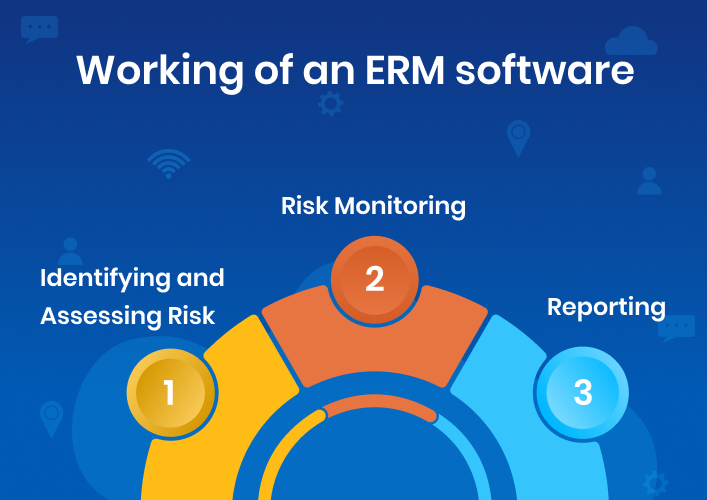Working of an ERM software

If your company is serious about improving its risk management, enterprise risk management software is the way to go. ERM software solutions simplify the process of identifying, assessing, mitigating, and monitoring risks for firms with their robust features. By using this program, businesses may improve their preparations and agility.
- Identifying and Assessing Risk: Internal reports, external databases, and other risk indicators are only some of the places where users might go to get information. Users may assess the likelihood of each danger once they have been made aware of the possible threats. Risk assessments allow businesses to rank potential threats in order of severity.
- Risk Monitoring: Enterprise risk management software facilitates the development and execution of preventative measures. Users may organize and assign work to the right people, set due dates, and track the development of preventative measures. Monitoring risks is crucial to ensure that existing mitigation strategies remain effective and that new hazards are addressed in a timely manner. Dashboards, alerts, and automatic reports are all part of the software’s real-time monitoring capabilities.
- Reporting: With the ERM software’s robust reporting and analytics features, organizations may generate insights, identify patterns, and assess risk exposure across many projects or business units. It may be combined with other business systems including accounting, regulatory, and project management tools to provide a comprehensive view of the company’s exposure to risk.
Steps to integrate custom ERM software with existing systems
Systematically aligning the final solution with the organization’s risk management strategy and ensuring smooth integration with existing systems are two primary goals of custom ERM software development.
- It is necessary to undertake a thorough evaluation of your risk management requirements to properly manage risk inside your firm. By doing this analysis, you may determine which sectors would benefit most from using enterprise risk management software to automate and simplify operations. Describe in detail what you want to accomplish by creating the software.
- The system design for this solution would involve a number of software modules depending on the requirements obtained. Data storage, processing, UI, and system integration are just some of these modules.
- Once the system architectural design is complete, the team may begin developing the software using an agile methodology and the established design standards. Each module’s efficiency and usefulness are guaranteed by this iterative procedure.
- The compatibility and smooth data transfer between the custom enterprise risk management software and the rest of the organization’s systems are made possible through system integration. The CRM, ERP, financial, and compliance systems in use now will be merged with the bespoke ERM software.
- The QA team does extensive testing on the custom software prior to full deployment in order to identify and resolve any issues. At this point, testers bring in important users and other stakeholders to get their input and make any required improvements based on what they learn.
- After the implementation of the system, continuous maintenance is crucial for keeping the tailored ERM system updated and in step with the business’s changing requirements.
Cost to develop custom ERM software
The total amount of funds needed to create an ERM system is very variable. The construction of a bespoke ERM system is a lengthy process that requires extensive planning, design, coding, testing, and integration in order to meet the specific requirements of an individual business.
The price tag for creating an ERM system might vary from $40,000 to $200,000. Larger projects with more features usually have greater prices, whereas simpler ERM software solutions may be more affordable for smaller businesses. Furthermore, it depends on the location and the expertise of the software development company, choice of technology, complexity, integration features, and more.
Conclusion
In today’s ever-changing and uncertain corporate environment, ERM software is an indispensable tool. It is a proactive and strategic asset for businesses in a world where complexity, volatility, and uncertainty are on the rise. For this reason, every progressive business serious about long-term development and risk management must embrace it.
FAQs
What is ERM software?
Why do organizations need ERM software?
How does the ERM system differ from other risk management tools?
Can small businesses benefit from the ERM system?
What features should I look for in the ERM system?
Ravi Bhojani is the Chief Marketing Officer (CMO) at Alian Software, where he spearheads the company’s marketing strategies and drives its brand presence in the competitive IT services landscape. With over a decade of experience in the technology and marketing sectors, Ravi has consistently demonstrated his ability to blend innovative marketing techniques with deep industry knowledge to deliver outstanding results.